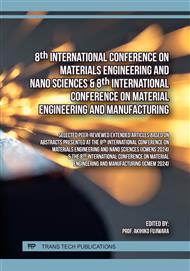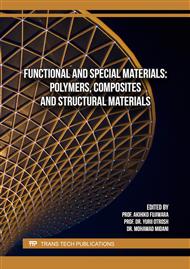[1]
D. Kilcast: Texture in Food. (1st ed., Woodhead Publishing Limited, Ablington)
Google Scholar
[2]
M.H. Saeidirad, A. Rohani and S. Zarifneshat: Computers and Electronics in Agriculture. Vol. 98 (2013), pp.1-7
Google Scholar
[3]
V. Kalyanasundarum, and S.R. Holdsworth: Prediction of Forward Creep Behavior from Stress Relaxation Data for 10% Cr Steel at 600°C. Trans Indian Inst Met. 69 (2016), pp.573-578.
DOI: 10.1007/s12666-015-0776-5
Google Scholar
[4]
J. Guo, H. Shi and W. Meng: Prediction Methodology of Creep Performance from Stress Relaxation Measurements. Applied Mechanics and Materials Vol.401-403, (2013), pp.920-923.
DOI: 10.4028/www.scientific.net/amm.401-403.920
Google Scholar
[5]
M. C. Saha, B. Barua, Incorporating Density and Temperature in the Stretched Exponential Model for Predicting Stress Relaxation Behavior of Polymer Foams, Journal of Engineering Materials and Technology 138, (2016).
DOI: 10.1115/1.4031426
Google Scholar
[6]
P. Poapongsakorn and C. Kanchanomai, Time-dependent deformation of closed-cell PVC Foam, Journal of Cellular Plastics 47, (2011), pp.323-336.
DOI: 10.1177/0021955x11401014
Google Scholar
[7]
S. Altarazi, M. Ammouri, and A. Hijazi, Artificial neural network modeling to evaluate polyvinylchloride composites' properties, Computational Materials Science 153, (2018), pp.1-9.
DOI: 10.1016/j.commatsci.2018.06.003
Google Scholar
[8]
U. Devadiga, R.K.R. Poojary, and P. Fernandes, Artificial neural network technique to predict the properties of multiwall carbon nanotube-fly ash reinforced aluminium composites, J Mater Res Technol. (2019), 8(5), pp.3970-3977.
DOI: 10.1016/j.jmrt.2019.07.005
Google Scholar
[9]
M.M. Gupta, J. Jin, and N. Homma, 2003: Static and Dynamic Neural Networks, From Fundamental to Advanced Theory, John Wiley & Sons, Inc. Hoboken, New Jersey.
Google Scholar
[10]
L. J. Gibson and M. F. Ashby, Cellular solids: Structure and properties (2 Ed), Cambridge University Press, 1997.
Google Scholar
[11]
M. Petru, O. Novak, Measurement and Numerical Modeling of Mechanical Properties of Polyurethane Foam, (Intech open Chapter 4). 2017, pp.86-96.
Google Scholar
[12]
ISO 13314:2011 Mechanical testing of metals-Ductility testing – Compression test for porous and cellular machine.
DOI: 10.3403/30203544
Google Scholar
[13]
ASTM E328-13, "Standard test Method for Stress relaxation Test for Materials and Structure", West Conshohocken, PA: ASTM International, 2013.
Google Scholar



